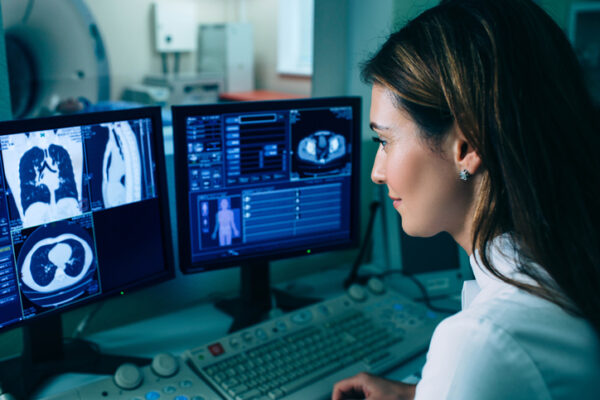The potential for digital healthcare to deliver time savings for medical practitioners is well documented. Dr. Eric Topol’s Topol Review, on preparing the health workforce to deliver this digital future, published earlier this year, highlights the “gift of time” as a major opportunity arising from digital health services. The report details the skills clinicians need to acquire to take advantage of these new digital technologies. Furthermore, it calls for the adoption of such technologies to, wherever possible, enable clinicians to gain more time to care and interact directly with patients, to enhance the patient-clinician relationship and improve the patient experience and patient safety.
Technologies such as AI and robotics have seen huge leaps in development and deployment in recent years and there is therefore a need to ensure the medical field, and clinicians in particular, keep pace with the opportunities these technologies are driving. The progress in deep learning autocontouring for cancer treatment, whereby contours drawn using deep learning trained software are mostly indistinguishable from human-drawn contours, is an excellent example of how AI is well placed to deliver on the promise of Topol’s ‘gift of time’. Indeed according to recent research published by the American Association of Physicists in Medicine, software generated contours, reviewed and refined by clinicians to outline healthy and cancerous tissue, have been found to offer time savings of up to 77% for some organs, when compared to the standard clinical workflow.

Health Benefit Consultants, Share Your Expert Insights in Our Survey
Hugh Bettesworth Hugh Bettesworth is the CEO of Mirada Medical. He has worked in the software industry for over twenty-four years, the last twenty in medical software and digital health. He joined Mirada Medical in 2001 and led a management buyout from Siemens in 2009 which re-established Mirada’s independent status. This independence provided the platform […]
However, the potential represented by these technologies and the promise of AI in cancer treatment extends beyond timesaving alone. For example, by mimicking the repetitive tasks required for detection and quantification of certain types of cancers, AI-enablement frees up healthcare professionals to focus on delivering personalized care, transforming outcomes for patients. There is also the potential for AI to “de-skill” tasks to more junior practitioners, maintaining clinical quality but helping to address training bottlenecks that constrain many global healthcare systems. To deliver on this promise, solutions developers must continue to work closely with medical centers of clinical excellence to research and explore opportunities to build AI solutions into treatment workflows from the planning stages onwards to deliver the greatest results.
For example, AI will enable routine delivery of more effective ‘adaptive’ treatments. While the delineation of healthy and cancerous tissue is currently typically done at the beginning of a course of radiation therapy, due to its resource-intensive manual application, the treatment of cancer is a dynamic process where the cancerous tissue may grow or shrink, spread or remain isolated over time. As a result, repeated re-contouring can unlock more accurate, adaptive radiation therapy in practice. It can also help reduce toxicity levels in patients by ensuring radiation is continually re-targeted at cancerous tissue, minimizing the impact on surrounding healthy organs.
This in turn can help enable normal tissue preservation and healthy organ functioning, enabling excellent quality of life after care. For instance, one typical and very well-established example is that by sparing the salivary glands, we can help ensure patients continue to benefit from the production of saliva and remove the risk of xerostomia (dry mouth), which can otherwise be a source of patient discomfort (“Xerostomia after Radiotherapy for Oral and Oropharyngeal Cancer”, Frontiers in Oncology, 2016).
Furthermore, there are opportunities for AI to be applied more broadly to radiotherapy treatment planning, such as providing recommendations on treatment dosage in line with clinical best practice standards and previously learned outcomes. These can then be reviewed and tailored by clinicians contributing to the widespread proliferation of cutting-edge treatments and optimal outcomes to global populations

A Deep-dive Into Specialty Pharma
A specialty drug is a class of prescription medications used to treat complex, chronic or rare medical conditions. Although this classification was originally intended to define the treatment of rare, also termed “orphan” diseases, affecting fewer than 200,000 people in the US, more recently, specialty drugs have emerged as the cornerstone of treatment for chronic and complex diseases such as cancer, autoimmune conditions, diabetes, hepatitis C, and HIV/AIDS.
As the Topol Review anticipates, in future we can expect to see a dramatic increase in the speed and scalability of the interpretation of medical data by AI, informing more precise, personalized, adaptive medical care. To make the most of this, we need to ensure that healthcare practitioners are provided with the necessary training needed to embrace a new age of digital tools, as complementary to their work. And we need to continue to work closely with medical centers internationally to roll-out the application of AI to support clinicians and extend the benefits to patients around the globe.
Photo: Darunechka, Getty Images
Hugh Bettesworth is the CEO of Mirada Medical. He has worked in the software industry for over twenty-four years, the last twenty in medical software and digital health. He joined Mirada Medical in 2001 and led a management buyout from Siemens in 2009 which re-established Mirada’s independent status. This independence provided the platform for the innovative software developments that have resulted in Mirada’s subsequent growth and leading technical position today. Since 2009, Mirada has experienced 10-fold growth and the company’s advanced software technologies have been deployed in around 2000 cancer treatment centres worldwide.













